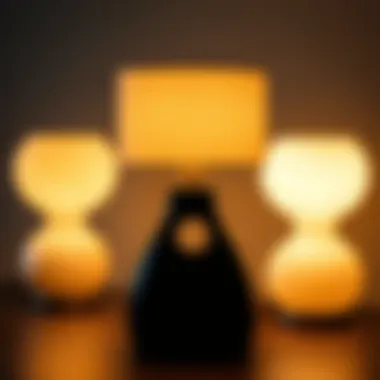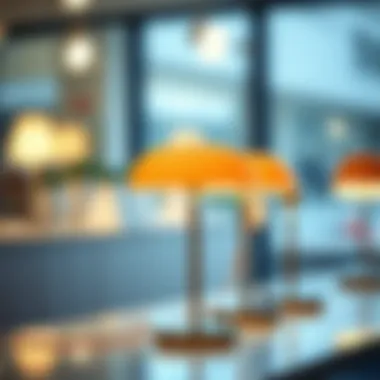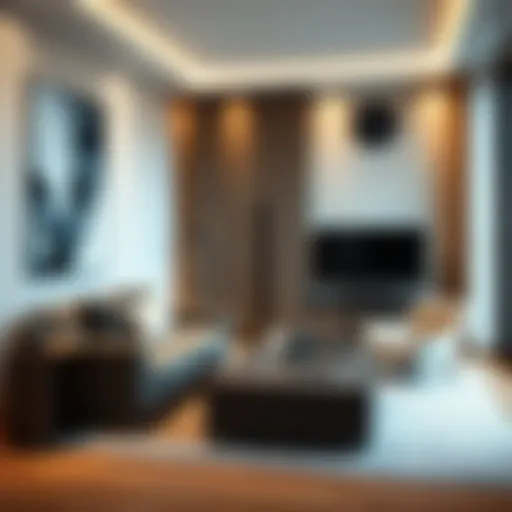Exploring Modern Table Lamps in Interior Design


Intro
In the realm of interior design, lighting serves as the unsung hero. Among the myriad of lighting options available, modern table lamps stand out, straddling the line between pure functionality and artistic expression. These pieces not only illuminate spaces but also add character and sophistication to a room's aesthetic.
Understanding how to select and integrate modern table lamps is pivotal for homeowners and designers alike. This guide aims to explore the significance of these fixtures in contemporary settings, the current trends influencing their design, and the practical considerations to keep in mind when incorporating them into your decor.
Modern table lamps come in various styles, materials, and technologies, reflecting the diverse preferences of today's consumers. From sleek, minimalist designs to ornate, statement-making pieces, they cater to a broad range of tastes.
This comprehensive guide will unfold the intricate tapestry of modern table lamps, providing valuable insights geared towards enhancing the ambience and usability of your living spaces. Let's dive deeper.
Understanding Modern Table Lamps
Table lamps play a critical role in modern interior design, melding utility with aesthetic appeal. The illumination they provide enhances the functionality of a space while also serving as a statement piece that reflects individual style. In this comprehensive guide, we will explore various elements of modern table lamps, emphasizing how they contribute not just light but also ambiance to contemporary homes.
The Role of Table Lamps in Interior Design
Table lamps are much more than mere lighting fixtures; they are strategic design elements. The right lamp can draw the eyes, create focal points, and bring life to an otherwise dull corner. Think of a sleek metal lamp casting soft light on a vintage bookshelf, or a bold-colored lamp standing on a minimalist desk. Each lamp can shape the mood of a room, inviting conversations or encouraging relaxation.
Moreover, table lamps serve a practical purpose. Unlike ceiling lights, which can be overwhelming, table lamps allow for flexible lighting solutions. In spaces where ambiance and intensity are key, adjustable lamps provide exactly what’s needed. This can be particularly beneficial in multipurpose spaces, like a guest room that doubles as a home office.
Historical Context of Table Lamp Design
To fully appreciate the modern table lamp, one must understand its evolution. The journey began many centuries ago, where primitive forms of lighting used oil or candle-based designs. By the late 19th century, electricity ushered in a new era, drastically transforming lamp design and functionality. The advent of Art Nouveau introduced decorative fixtures, where form and beauty were prioritized alongside functionality.
Fast forward to the mid-20th century; we witnessed a boom in modernism, where simplicity and minimalism ruled the day. Designers like George Nelson and Richard Neutra crafted pieces that embodied the spirit of progress—often playing with geometry and innovative materials. Today, contemporary table lamps often pay homage to these classical styles while incorporating advanced lighting technologies and sustainable materials.
"The evolution of table lamps reflects changing lifestyles and technology, from flickering candles to high-tech LED fixtures."
Understanding these shifts is crucial for anyone looking to select or design a table lamp. Recognizing what shapes and styles resonate historically can inform contemporary choices, ensuring they serve both function and artistry. As we dive deeper into this guide, we shall explore how these themes influence current market trends and user preferences.
Defining Modern Style
In the realm of contemporary interior design, defining modern style can be likened to pinning down a moving target. It's a fluid concept that evolves with societal trends, technological innovations, and shifts in consumer preferences. However, its importance cannot be overstated, especially when selecting table lamps that enhance the aesthetic appeal and functionality of a space. Modern style encapsulates a commitment to simplicity and a celebration of materials and forms that evoke both practicality and beauty.
Characteristics of Modern Design
Modern design embodies several core characteristics that set it apart from other styles. One major trait is minimalism, which promotes clean lines and uncluttered spaces. Items like table lamps serve not just functional roles but also act as conversation starters, blending seamlessly with their surroundings. Key characteristics include:
- Functional Forms: Each design element must serve a purpose. When it comes to table lamps, this means both providing adequate light and making a visual statement without overwhelming the room.
- Natural Materials: The use of materials such as wood, metal, and glass communicates a connection to the environment. You’ll often find table lamps that incorporate reclaimed wood or sleek metals that hint at industrial undertones.
- Neutral Color Palettes: Modern designs typically favor muted shades. While boisterous colors might dominate in other styles, modern table lamps often don whites, grays, and earth tones, providing a backdrop for subtle accents.
- Open Spaces: Modern style encourages airy spaces, and table lamps must contribute to this by not appearing cumbersome or bulky. These lamps often adopt slim silhouettes or multi-functional designs that complement an open floor plan.
By focusing on such characteristics, table lamps become integral to a cohesive visual narrative in any living space.
Modern Versus Traditional Table Lamps
When one compares modern and traditional table lamps, it’s striking how divergent they can be in concept and execution. Traditional lamps often bear intricate details, such as ornate bases and elaborate patterns. In contrast, modern lamps embrace a more streamlined approach, eschewing heavy embellishments for straightforward designs.
Some key differences include:
- Design Philosophy: Traditional lamps might prioritize decorative complexity whereas modern lamps emphasize simplicity. You can see this in designs that favor geometric shapes over curvaceous forms.
- Material Choices: Where traditional lamps may lean on materials like ceramic and stained glass, modern iterations may utilize aluminum or acrylic, resulting in a lighter appearance.
- Functionality vs. Aesthetics: Modern lamps strive for a balance between functionality and aesthetics. Many are now equipped with features such as touch controls or adjustable heights, promoting ease of use without compromising style.
- Lighting Technology: In terms of light sources, traditional lamps typically use incandescent bulbs, while modern lamps often incorporate LED technology, which is energy efficient and far more versatile in terms of light output.
Understanding these distinctions helps in making informed purchasing decisions, aligning personal taste with practical needs.
Materials and Finishes
The choice of materials and finishes in modern table lamps plays a crucial role in the aesthetics and functionality of these lighting pieces. Selecting the right components not only affects the durability and overall look of the lamp but also how well it fits into the existing interior design of a room. The interplay between materials and finishes can make or break the ambiance you’re aiming for, whether it be cozy, minimalistic, or something more eclectic. Therefore, understanding the distinct materials used in table lamps is paramount.
Common Materials Used in Modern Table Lamps
Metals
When thinking about table lamps, metals are often at the forefront of design choices. A key aspect of metals in lamp construction is their durability. Favorable metals like steel, brass, and aluminum contribute to a lamp’s longevity, making them a popular option among homeowners. The reflective quality of metals not only enhances the brightness of the light emitted but also integrates into modern designs seamlessly.
One unique feature of metals is their ability to coexist with various styles, from industrial to contemporary. However, metals can conduct heat, which is an important factor to consider for safety reasons, especially if the lamp uses high-wattage bulbs.
Glass
Glass is another sought-after material that lends a sense of elegance to lighting solutions. A standout characteristic of glass is its transparency, allowing light to diffuse beautifully, creating a warm and inviting atmosphere. Glass table lamps can come in various finishes—clear, frosted, or colored—adding versatility to the interior aesthetic.
One unique aspect of glass lamps is their ability to adopt various shapes, from sculptural to traditional. However, the fragility of glass may pose a downside in households with children or pets, where accidents can happen.


Wood
Wood stands out for its natural warmth, making it a favored choice for creating cozy, inviting spaces. A key characteristic of wooden table lamps is their textural appeal, bringing an organic feel to modern designs. Different types of wood, like oak, walnut, or teak, offer unique grains and colors, thus enhancing the overall decor.
Wood does have its downsides, such as susceptibility to scratching or warping with time; however, with appropriate finishes and care, a wooden lamp can become a timeless centerpiece in your living area.
Plastic
Plastic might not strike you as classy, but it holds an important position in modern table lamp design. Its affordability and lightweight nature make it an accessible option for many. Available in a wide array of colors and styles, plastic lamps can bring a playful vibe to any room.
One notable feature of plastic is its moldability, allowing for innovative shapes and designs that can’t easily be achieved with harder materials. Nevertheless, the perception of plastic can sometimes lean towards being less premium, and availability of high-quality options is a consideration for discerning buyers.
Choosing the Right Finish for Your Decor
Selecting the right finish for a table lamp is equally as critical as choosing its materials. Finishes can dramatically alter the appearance of a lamp and, by extension, the mood of the space it occupies. Various finishes like matte, glossy, or textured can complement different decor styles, adding layers of depth to the design.
Considerations such as the existing color palette, the type of lighting required, and the decorative scheme are all pivotal when selecting finishes. For instance, a matte black lamp may work splendidly for a modern minimalist decor, while a polished brass finish might enhance a vintage-inspired room. Ultimately, the right finish can unify a room while adding that touch of character that pulls everything together.
"The materials and finishes you choose for your modern table lamps are not just practical decisions but stylistic expressions in your home."
By thoroughly understanding these material nuances and the impact of finishes, you can curate a lighting scheme that perfectly aligns with your interior vision.
Types of Lighting Technologies
In the realm of modern table lamps, the choice of lighting technology plays a critical role in both functionality and ambiance. Understanding the available lighting technologies can empower homeowners, designers, and enthusiasts to make informed decisions, optimize energy usage, and enhance the aesthetic appeal of any space. This section delves into two prominent lighting technologies: LEDs and incandescent bulbs. Each has its own merits and drawbacks, making it essential to consider various aspects before making a selection.
LED Versus Incandescent
When choosing between LED and incandescent bulbs for table lamps, one must consider various factors like energy efficiency, lifespan, and light quality. LED (Light Emitting Diode) technology has made quite the splash in recent years, largely due to its unparalleled energy savings. An LED bulb uses about 75% less energy than an equivalent incandescent bulb, which translates to significant cost savings on energy bills over time.
Moreover, LEDs have an exceptionally long lifespan, often lasting 15,000 hours or more compared to the typical 1,000 hours for incandescent bulbs. This longevity can reduce the hassles of frequent replacements and contribute to less waste over time.
However, incandescent bulbs still hold a certain appeal for many. They emit a warm, soft light that many find more inviting and comforting compared to the sometimes harsh quality of LED light. For instance, in a cozy corner of a living room, an incandescent table lamp might create a welcoming atmosphere that feels inviting after a long day. While temperature options are available for LEDs, the warm glow of incandescent light is often considered irreplaceable for mood lighting.
Furthermore, incandescent bulbs are generally less expensive upfront, making them an accessible option for those on a budget. Though they may not be the most energy-efficient choice, their warmth and affordability can enhance the charm of a room.
Here’s a quick comparison:
- LED Bulbs
- Incandescent Bulbs
- Energy Efficient
- Long Lifespan
- Higher Initial Cost
- Various Color Temperatures Available
- Lower Initial Cost
- Warm Light Quality
- Shorter Lifespan
- Less Energy Efficient
Choosing between these two options often comes down to personal preference and specific needs. Is your priority energy efficiency, or are you looking for that cozy, golden glow? Each technology offers unique advantages, making it essential to weigh them carefully to complement your design goals and lifestyle.
Smart Lamps and Their Benefits
In our tech-driven age, smart lamps are carving out their niche in homes across the globe. These high-tech table lamps don’t just light up a room; they come equipped with features designed to enhance convenience and usability. With the ability to control brightness, color, and even patterns through a smartphone app, smart lamps have become more than a mere lighting fixture; they are a part of the rising smart home paradigm.
One of the standout features of smart lamps is their compatibility with home automation systems. They can be integrated with voice assistants like Amazon's Alexa or Google Assistant, allowing for hands-free operation. For instance, a simple voice command can adjust the brightness without you having to lift a finger. This convenience adds a layer of ease to daily routines, especially when your hands are full or you’re snuggled up on the couch.
Additionally, many smart lamps support customizable schedules. This means you can set a timer for your lamp to turn on or off at specific times, mimicking natural light patterns. For night owls, this can be particularly beneficial when trying to wake up gently at dawn, rather than being jolted from sleep. For those mindful of energy usage, these lamps can also help track and optimize power consumption.
Some of the differentiating features of smart lamps include:
- Adjustable Color Temperature: Switch from warm to cool light depending on mood or activity.
- Remote Control Access: Use your smartphone to manage your lamp from anywhere in the house.
- Energy Monitoring: Keep an eye on energy usage and adjust settings to reduce costs.
While smart lamps come at a higher price point than traditional options, the added functionalities often justify the investment. Moreover, they cater to both aesthetic and functional needs, making them a worthy consideration for modern interiors.
Selecting the Right Table Lamp
Choosing the right table lamp is no small feat. It's not merely about finding a light source; it's about enhancing a space, adding character, and addressing specific needs. A well-chosen lamp can transform an ordinary room into something truly exceptional while providing the necessary illumination. Thus, this section highlights the essential aspects to consider when selecting the perfect table lamp for your environment.
Assessing Your Space and Needs
Size and Scale
When it comes to size and scale, you might say it’s akin to finding the perfect pair of shoes. Just as wearing shoes that don’t fit can make an outing uncomfortable, a lamp that's too large or too small can throw off the balance of a room. Take the time to measure your surfaces—be it a side table, bedside, or desk. A lamp that doesn’t visually align with the furniture around it can stand out for all the wrong reasons.


To put it plainly, a large lamp in a small room can make the space feel cramped, while a tiny lamp in a sprawling living area may leave the space feeling incomplete. The eye naturally seeks balance; therefore, aligning the lamp with the scale of your furniture is paramount. Imagine a stately wooden lamp beside a humble reading chair; the disparity in size inevitably becomes the focus.
Key Characteristic
One notable feature of size and scale is the ability to affect perception. A taller lamp can draw the eye upwards, creating the illusion of height in a room with low ceilings. Conversely, a more diminutive lamp might bring a cozy feel, especially in a reading nook.
Light Level Requirements
Let’s delve into light level requirements, a facet often overlooked when buying lamps. Are you looking for a soothing glow for an intimate setting, or do you require bright, focused light for tasks like reading or sewing? Different activities call for different lighting. If you’ve ever tried flipping through a book under a dim bulb, you’ll understand this all too well.
The key characteristic of light levels is their ability to impact mood and functionality. Bright light can energize, making it suitable for spaces where work gets done, while softer light typically invites calmness, ideal for bedrooms.
Unique Feature
A unique feature of light level requirements is the option for adjustable lamps, which can provide versatility. An adjustable floor lamp, for instance, can change its brightness based on your needs—from a vibrant reading light to a soft glow for evening relaxation. However, do consider the disadvantages, such as the potential for higher energy consumption with brighter settings if the lamp lacks energy-saving features.
Understanding Lamp Height and Shade Size
Finally, a practical yet often neglected relationship exists between lamp height and shade size. A lamp should not only fit within the allotted area but also complement the overall design of a room. A general rule of thumb is that the bottom of the lampshade should ideally be at eye level when you’re seated. This ergonomic factor plays heavily into the lamp's utility, making it a crucial consideration.
When it comes to developing a harmonious look, it’s equally crucial that your shade matches the lamp’s proportion. An overly large shade on a slender base can feel top-heavy, much like a poorly constructed cake. You wouldn’t want it to topple.
Ending
Selecting just the right table lamp is an intricate dance involving your particular space and the specific light needs. Whether assessing size and scale, light levels, or understanding preferences in height and shade size, meticulous attention to detail can ensure that your choice enhances the aesthetic while serving its practical purpose.
"A well-lit space is a well-loved space—one where form and function gracefully intertwine."
By focusing on these vital aspects, homeowners, designers, and DIYers alike can make informed decisions that contribute to the overall ambiance and usability of any room.
Incorporating Table Lamps into Different Rooms
When it comes to illuminating your home, table lamps play a critical role in blending functionality with style. The unique ability of table lamps to enhance various spaces cannot be overstated. They serve not just as light sources but also as design statements, providing warmth and character to different settings. In this section, we will explore how to effectively incorporate table lamps into diverse rooms, weighing their benefits and considerations, including placement, style, and function, tailored to achieve an optimal balance.
Living Room Lighting Concepts
The living room is often considered the heart of a home. It's where families gather, guests are entertained, and memories are created. As such, table lamps in this space must tick both the aesthetic and practical boxes. Selecting the right table lamp can create ambiance, highlight features, and facilitate conversation.
Consider positioning a pair of table lamps on either end of a sectional sofa. This not only provides symmetric illumination but also frames the seating area beautifully. When choosing lamps, think about the height and shade size to ensure they complement the furniture rather than compete with it. A simple ceramic lamp with a warm finish can add softness, while a sleek metal option can inject a contemporary vibe.
"Lighting is not just about functionality; it’s also about design and atmosphere. Choose wisely."
Some factors to consider:
- Layered Light: Use table lamps to supplement overhead lighting, creating a layered light experience.
- Design Cohesion: Ensure the lamp style matches the room’s overall aesthetic, be it traditional, modern, or eclectic.
- Ambiance: Soft, warm light can create an inviting atmosphere, while brighter, cooler light may work for more vibrant social settings.
Bedroom Ambiance with Table Lamps
In a bedroom, table lamps are essential for crafting a cozy and relaxing atmosphere. They are not merely functional for reading or working but also contribute significantly to the overall decor and vibe of the sanctuary.
Using table lamps at bedside offers practical illumination to wind down in the evening but has its nuances. Consider selecting lamps with adjustable brightness settings or softer shades to avoid an overly harsh glow. For instance, a lamp with a fabric shade can diffuse light, producing a gentle glow that encourages relaxation.
Keep in mind the dimension of your bedside table; a lamp that’s too tall can feel overwhelming, while one that’s too short may not provide adequate light for reading an engaging book. Styles can range from vintage, using antique brass finishes, to ultra-modern, with sculptural bases that make a statement without overwhelming the space.
Key points include:
- Match Lamp Height with Bed Height: Ideally, the bottom of the lamp shade should be at eye level when you are seated in bed.
- Using Colors Wisely: Choose calming hues that promote tranquility, like soft blues or greens, which can influence mood positively.
Table Lamps in Office Settings
With the rise of remote work, the home office has become more prominent, and table lamps here serve dual purposes: functionality and enhancing focus. An adequate amount of light can significantly improve productivity while limiting eye strain.
Consider the desk lamp not merely as a light source but also as a design accent to reflect your personality. Go for lamps with adjustable arms, allowing you to direct light precisely where you need it. A drafty or poorly lit workspace can be deterred with thoughtful placement and suitable design choices.
Within this space, functional doesn’t have to mean boring. A geometric lamp in a bright shade can uplift the aesthetic and keep the area energized. Equally, a minimalist lamp with clean lines can help maintain a sleek look that promotes concentration.
Things to take into account:
- Brightness Level: Adjust brightness with a lamp that includes a dimmer functionality, catering to varied tasks throughout the day.
- Space-saving Solutions: Consider lamps with a smaller footprint, especially if desk space is at a premium, to retain a clutter-free environment.


In summary, incorporating table lamps into different rooms requires consideration of function, style, and the specific ambiance desired. One must balance illuminating needs with design elements that express personal style, turning each space into a reflection of its inhabitant.
Trends in Modern Table Lamp Design
The landscape of modern table lamp design is dynamic and varied, shaped by contemporary needs and aesthetic preferences. Understanding these trends provides insight not just into lighting options but also into how they can elevate interior spaces. Homeowners and designers alike can benefit greatly from being attuned to what's fashionable. These trends influence how we think about illumination, functionality, and integration within a home. In essence, modern table lamps are not merely sources of light, but key elements that contribute to the overall decor narrative.
Minimalism and Simplicity
The minimalist aesthetic is a fundamental trend across various domains of design, and table lamps are no exception. This approach favors streamlined shapes and uncomplicated forms. Think about a lamp with a sleek metal base and a simple shade; such designs imbue spaces with a sense of calm and sophistication. In a world brimming with distractions, homeowners are gravitating towards designs that emphasize tranquility.
- Benefits:
- Clutter-free environments: Simplified lighting fixtures help keep spaces organized.
- Versatility: Minimalist lamps can blend seamlessly with different styles—from modern chic to industrial vibes.
However, minimalism isn't just about stripping down; it also embodies a thoughtful choice of materials and finishes. For instance, a white ceramic lamp presents a clean look but can also serve as a statement piece in its own right. Sounds simple, yet the impact is far-reaching.
Bold Colors and Unique Shapes
While minimalism promotes simplicity, another compelling trend is the embrace of bold colors and unique shapes. This is where creativity blossoms. Bright, lively hues like electric blue or vivid orange can inject personality into otherwise muted spaces.
- Unique Shapes: Think lamps shaped like geometric forms or even organic silhouettes. These eye-catching designs act not only as lighting but also as sculpture-like art pieces.
The interplay between color and shape provides a perfect opportunity to showcase individuality. Homeowners can choose lamps that speak to their personal style, making a room feel more curated. It’s a delightful way to break the monotony of conventional decor, adding flair and a sense of adventure to interiors.
Sustainable and Eco-Friendly Options
With growing awareness around environmental issues, the trend towards sustainable and eco-friendly table lamps cannot be ignored. Many consumers are prioritizing products made from recycled or sustainably sourced materials.
- Examples:
- Lamps crafted from reclaimed wood or upcycled plastics.
- Energy-efficient LED bulbs that drastically cut down energy consumption.
The appeal of these options lies not only in their environmental benefits but also in the stories they tell. Each piece often carries a unique history and character, distinguishing it from mass-produced alternatives. Notably, this trend caters to a conscientious market that values sustainability as an integral part of lifestyle choices.
In the contemporary design world, the intersection of aesthetics and sustainability is more relevant than ever. Homeowners are asked to rethink their choices: What story does your lamp tell?
Embracing these trends in modern table lamp design enriches the quest for personal style. It's not simply about what produces light, but how these pieces function as narratives within our environments. From minimalistic elegance to bold proclamations of color and the importance of sustainability, modern table lamps indeed serve multiple roles, harmonizing function with flair.
Maintaining Your Table Lamps
Maintaining your table lamps is often an overlooked aspect of home decor that has a lasting impact on the overall aesthetics and functionality of a space. Proper care not only extends the lifespan of these fixtures but also maintains their appearance and performance. A well-kept lamp can become a focal point or a subtle accent in a room, pulling together the decor with ease.
Regular maintenance involves a few straightforward practices that ensure your lamps serve you well without losing their charm. First and foremost, it's essential to keep your lamps clean. Dust and dirt can accumulate quickly, dulling finishes and casting unwanted shadows. Keeping your lamps pristine contributes significantly to the visual appeal and can even enhance the quality of light emitted.
Additionally, regular checks for functionality, such as bulb replacements and wiring inspections, are crucial. A lamp that no longer lights up serves little purpose, and faulty wiring can pose safety hazards. A proactive approach to maintenance not only helps in avoiding potential issues but also imbues the space with a sense of care and attention.
"Take care of your lamp, and it will take care of your light."
Cleaning Techniques for Different Materials
When it comes to cleaning table lamps, the material plays a vital role in determining the approach. Not all surfaces can withstand harsh chemicals or abrasive tools. Below are common materials used in modern table lamps and the best cleaning techniques for each:
- Metal: For metal finishes, a gentle solution of soap and water usually does the trick. Use a soft cloth to wipe down surfaces, and make sure to dry them thoroughly afterward to prevent tarnishing or rusting. Avoid abrasive cleaners that can scratch the surface.
- Glass: Glass lamps may accumulate fingerprints and dust over time. A mixture of equal parts water and vinegar sprayed onto a soft cloth can clean without streaks. Be gentle, especially if the glass has intricate designs.
- Wood: Wood finishes often require a bit more care. A dry microfiber cloth should suffice for dusting. To remove stains or buildup, mix a solution of water with a few drops of dish soap. Apply with a soft cloth, then dry the wood immediately to avoid damage.
- Plastic: Plastic lamps are generally low maintenance. Warm soapy water on a cloth can clean them effectively. However, avoid using high heat to dry them, as it may warp the material.
Replacing Bulbs and Shades
Lamp maintenance also involves periodically replacing bulbs and shades to keep the lighting consistent and the aesthetic sharp. Depending on the type of lamp, the process may vary slightly.
- Bulbs: To replace a bulb, first ensure that the lamp is unplugged or the switch is turned off. Allow bulbs to cool if they have been recently used. Choose the right type and wattage; LEDs, for example, are more energy-efficient and can last longer than traditional incandescent bulbs. Remove the old bulb by twisting it out of the socket and replace it with a new one by twisting it in firmly, without applying too much force.
- Shades: A lamp shade can alter the light quality and the room's ambiance. To replace one, remove the old shade carefully, ensuring you’re not damaging any components. Most shades will either slide off the harp or require a few screws to be undone. Choose a new shade that complements your lamp's style and the overall decor of your room. Different shapes and colors can transform the character of a lamp unexpectedly.
These maintenance practices not only help in ensuring the longevity of your table lamps but also improve the overall visual and functional value they provide in your home. Regular care turns a simple lamp into a statement piece that reflects your style.
Ending: The Enduring Appeal of Modern Table Lamps
When one considers the evolving landscape of interior design, modern table lamps hold a vital position. They represent not only a source of illumination but also an exquisite blend of art and functionality. Their presence can dramatically transform a space, providing both practical lighting and an aesthetic focal point.
Balancing Functionality and Aesthetics
In the world of design, achieving the right balance between functionality and aesthetics is crucial. Modern table lamps serve this dual purpose quite effectively. On one hand, they illuminate workspaces or create cozy atmospheres in living areas; on the other hand, their unique designs either harmonize with or stand out against the backdrop of existing décor.
- Functionality: The practicality of a lamp can be assessed through several factors: the kind of light it produces, the adjustability of brightness, and its placement options. For instance, a lamp with a flexible arm can direct light precisely where it’s needed, making it ideal for reading or studying.
- Aesthetics: Meanwhile, styles range from sleek modern lines to intricate vintage designs, catering to a wide audience. A lamp shaped like a delicate tree branch could evoke a serene environment, while a geometric fixture might inject vibrancy to a minimalistic space.
Modern table lamps are more than mere light sources; they're an expression of personal style and a reflection of one’s interior design ethos.
Achieving a harmonious integration of these elements demands careful consideration. Homeowners and designers must therefore become vigilant curators of their environments. With so many unique designs and technologies available, making a choice can feel overwhelming. Yet, the key lies in understanding one’s space, needs, and aesthetic preferences.
To summarize, modern table lamps provide essential lighting while serving as artistic statements in a home. They enhance usability and mood, making them indispensable tools in contemporary interior design. As tastes and technologies continue to evolve, the charm of these fixtures—when chosen wisely—will ensure enduring appeal in any setting.















